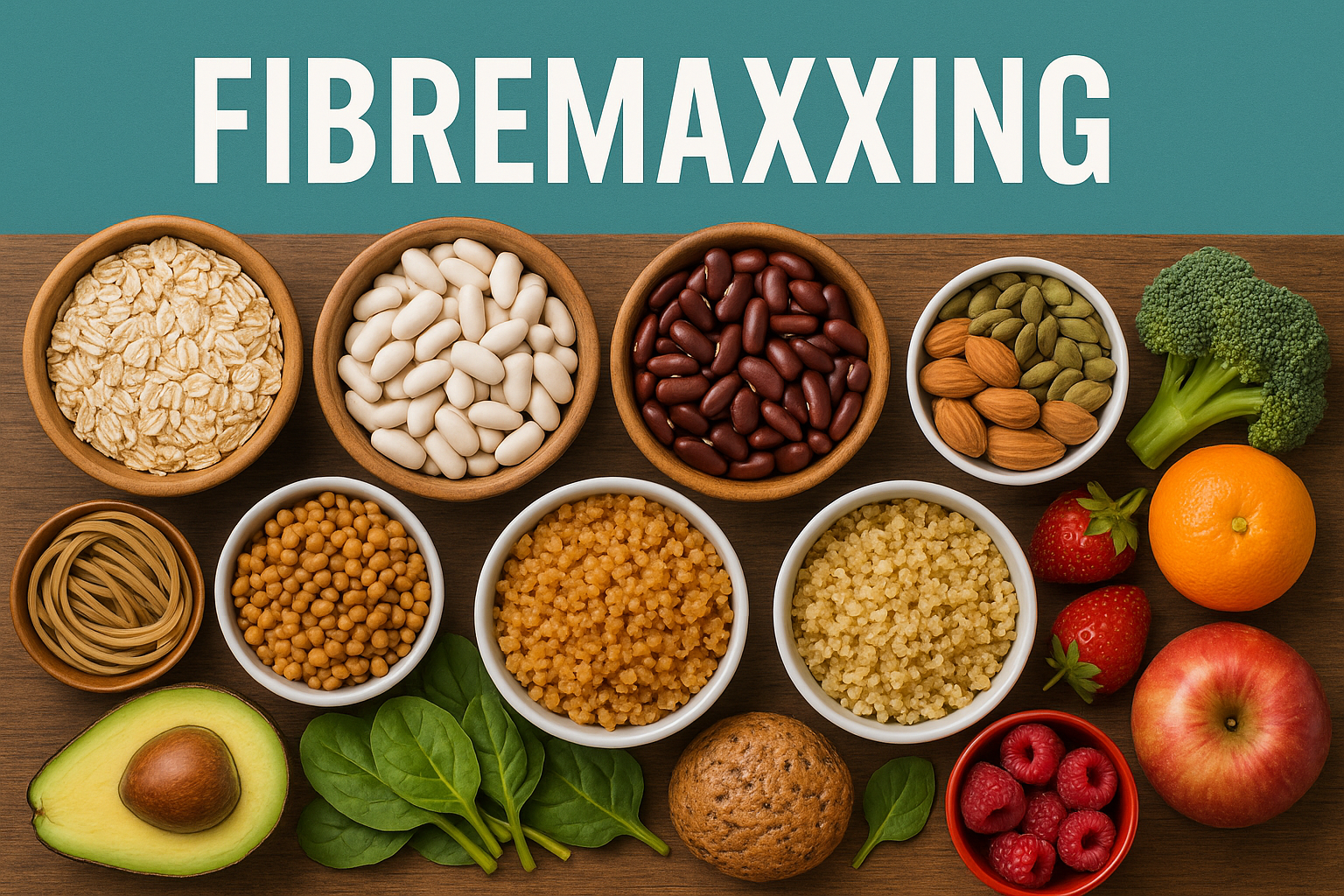Fibremaxxing is the viral health trend dominating 2025, especially among wellness influencers, TikTok creators, and health-conscious millennials. But what exactly is it? Simply put, fibremaxxing is the intentional increase of dietary fiber intake to optimize digestion, support gut health, regulate blood sugar, and enhance overall well-being. While fiber has always been essential, the fibremaxxing movement turns it into a lifestyle rooted in science, backed by expert recommendations, and fueled by social media enthusiasm.
Let’s explore how this trend is reshaping the way we eat—and what you need to know before diving in.
The Science Behind Fibremaxxing
How Does Fiber Improve Your Health?
Fiber plays a key role in:
- Regulating bowel movements and preventing constipation.
- Feeding beneficial gut bacteria, which support immunity, reduce inflammation, and improve mental health through the gut-brain axis.
- Controlling blood sugar levels, especially helpful for diabetics and pre-diabetics by slowing glucose absorption.
- Supporting weight loss by increasing satiety, which reduces overall calorie consumption.
- Lowering cholesterol by binding to bile acids in the digestive system.
Numerous studies show that people who consume adequate fiber have a lower risk of cardiovascular disease, type 2 diabetes, colon cancer, and obesity.
Soluble vs. Insoluble Fiber: What’s the Difference?
- Soluble fiber (found in oats, chia seeds, psyllium husk, apples, and legumes) dissolves in water to form a gel-like substance. It slows digestion, promotes fullness, and helps regulate blood sugar and cholesterol levels.
- Insoluble fiber (found in whole grains, celery, cucumbers, and nuts) adds bulk to stool, promotes regular bowel movements, and helps prevent digestive issues like diverticulosis.
A well-rounded fibremaxxing routine includes both types of fiber to optimize gut and metabolic health.
Why Has Fibremaxxing Gone Viral?
Several cultural and scientific shifts have contributed to the rise of fibremaxxing:
- TikTok & Instagram influencers share “fiber challenge” videos, encouraging followers to hit 30g+ fiber/day.
- Digestive wellness awareness has surged, with probiotics, prebiotics, and fermented foods also trending.
- Biohacking communities advocate for fiber as a core component of longevity diets.
- Mental health and mood are increasingly being linked to gut microbiome health—fiber being a key player.
- Weight loss platforms like Noom and WW have embraced fiber as a cornerstone strategy.
- Health food brands now market high-fiber versions of popular snacks to meet demand.
Fibremaxxing fits perfectly into the fast-paced, convenience-driven lifestyle of 2025—providing a low-effort, high-impact wellness solution.
How to Start Fibremaxxing Safely
1. Know Your Daily Fiber Needs
Most adults need 25–38 grams of fiber daily, depending on age, gender, and activity level. Yet globally, the average intake remains shockingly low—around 10–15g/day.
2. Gradually Increase Fiber Intake
Ramping up too quickly can cause side effects like bloating, abdominal discomfort, or flatulence. A phased approach over 1–2 weeks allows your gut bacteria to adjust.
3. Drink Plenty of Water
Water activates fiber’s bulking and digestive benefits. Without adequate hydration, fiber can do more harm than good.
4. Choose Whole, Unprocessed Foods
Natural sources—like beans, lentils, vegetables, fruits, seeds, and whole grains—are ideal. Highly processed fiber bars and cereals often contain hidden sugars and lack diversity in fiber types.
5. Pair Fiber with Healthy Fats and Protein
This combination stabilizes blood sugar, supports sustained energy, and further enhances satiety. For example, avocado on whole grain toast or chia pudding with almond butter.
6. Rotate Fiber Sources
Variety supports microbiome diversity. Rotate different fiber sources weekly—such as barley, buckwheat, artichokes, beets, and kiwi.
7. Monitor and Track Progress
Use health tracking apps like MyFitnessPal or Cronometer to gauge fiber intake and note any digestive responses.
Potential Risks and Misconceptions
- More fiber isn’t always better: Consuming over 50g/day can interfere with iron, calcium, and magnesium absorption.
- Weight loss is not automatic: Fiber helps, but must be part of a holistic approach including sleep, hydration, and movement.
- Supplements ≠ whole foods: Prebiotic powders and psyllium husk lack phytonutrients, enzymes, and natural co-factors found in whole foods.
- Fiber isn’t just for digestion: It plays a systemic role in inflammation reduction, mental clarity, and immune regulation.
- Children and elderly caution: While beneficial, adjustments should be gradual and preferably supervised.
Fibremaxxing Meal Ideas (Extended)
Breakfast Ideas
- Steel-cut oats with sliced pear, cinnamon, flaxseed, and walnuts.
- Whole grain avocado toast with crushed hemp and tomato.
Lunch Ideas
- Lentil & quinoa bowl with chickpeas, grilled zucchini, kale, pumpkin seeds, and tahini dressing.
- Black bean wrap with red cabbage, salsa, and whole wheat tortilla.
Dinner Ideas
- Tofu stir-fry with soba noodles, bok choy, carrots, and sesame.
- Baked salmon with roasted sweet potatoes, asparagus, and a bulgur salad.
Snack Ideas
- Hummus with mixed veggie sticks (carrots, celery, bell peppers).
- Greek yogurt with chia and raspberries.
- Air-popped popcorn seasoned with olive oil and herbs.
Target Audience: Wellness Seekers & Health-Conscious Millennials
This article is crafted for:
- Urban professionals aiming to optimize health with minimal disruption.
- Wellness-curious Gen Z and millennial audiences familiar with gut health and biohacking trends.
- Individuals seeking natural approaches to weight loss, energy boost, and digestive clarity.
They demand evidence-based, practical advice that aligns with modern lifestyle and media habits.
Pro Tips: Expert Strategies to Maximize Fibremaxxing
- Start your day with fiber: Overnight oats, chia pudding, or a high-fiber smoothie.
- Don’t rely solely on fruit: Integrate legumes, root vegetables, and nuts.
- Fiber doesn’t mean boring: Explore global cuisines—Ethiopian lentil stews, Mediterranean tabbouleh.
- Read labels carefully: Look for “5g+ fiber per serving” benchmarks.
- Avoid ultra-processed fiber bars: Watch for sugar alcohols and additives.
- Track your intake: Log meals to keep fiber in the 25–38g sweet spot.
- Balance macronutrients: High-fiber diets need adequate protein and fats for best results.
- Don’t ignore physical activity: It works synergistically with fiber to support gut motility.
FAQ: Frequently Asked Questions
What happens if I consume too much fiber?
Excessive fiber can result in digestive stress, dehydration, or reduced mineral absorption. Balance is key.
Is fibremaxxing good for weight loss?
Yes—fiber helps curb hunger, balance blood sugar, and reduce binge-eating—but it’s most effective when part of an overall healthy lifestyle.
Can kids or elderly people try fibremaxxing?
Yes, but it must be done gradually and with tailored portions, considering individual digestion and nutritional needs.
What are the best high-fiber foods?
Chia seeds, flaxseeds, lentils, black beans, broccoli, quinoa, avocado, and raspberries.
Should I take fiber supplements?
Only when dietary fiber is insufficient. Even then, food-first is the gold standard.
Can fiber help with mental clarity?
Emerging research suggests fiber-rich diets support a healthier microbiome, which influences neurotransmitters and mood.
We’d Love to Hear From You!
Have you tried fibremaxxing or transformed your diet with high-fiber habits? Share your insights, favorite meals, or struggles in the comments below. Your voice adds value to the wellness community!
Sources: Harvard Health, Mayo Clinic, TikTok Trends Report, WHO Nutrition Division, Journal of Nutrition, Gut Microbiota Research Studies



